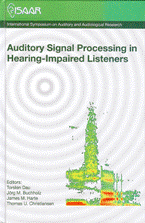Interpreting word-recognition data using the NAM and phonemic features
Resumé
The goal of this project was to examine acoustic and non-acoustic variables that may predict the relative ease or difficulty with which monosyllabic words presented in speech-spectrum noise are recognized. For the analysis, the 50% correct recognition data from the 24 listeners with normal hearing who participated in the Wilson and McArdle (2007) was used. The following acoustic, phonetic/phonological, and lexical variables were included in the evaluation: (1) rms; (2) duration; (3) consonant features (manner, place, and voicing for initial and nal phoneme); (4) vowel phoneme; (5) word frequency; (6) word familiarity; (7) neighborhood density; and (8) neighborhood frequency. The results showed significant correlations between the acoustic variables (i.e., rms, duration) and the 50% point. The results of the regression analysis found that 45% of the variance associated with the 50% point was accounted for by the acoustic and phonetic/phonological variables (i.e., consonant features, vowel phoneme) whereas only 3% of the variance was accounted for by a single lexical variable (i.e., word familiarity). Word frequency, neighborhood density, and neighborhood frequency were not found to be significant variables in the regression model. These ndings suggest that monosyllabic word-recognition-in-noise is more dependent on bottom-up processing than top-down processing. Thus, monosyllabic words may be more sensitive to changes in audibility when using speech-in-noise testing for rehabilitative outcomes such as in a pre/ post-hearing aid fitting format.
Referencer
Finney, D. J. (1952). “Statistical method in biological assay,” London: C. Griffen. Luce, P. A. and Pisoni, D. B. (1998). “Recognizing spoken words: The neighborhood activation model,” Ear Hear. 19, 1-36.
Miller, G. A., and Nicely, P. E. (1955). “An analysis of perceptual confusions among some English consonants,” J. Acoust. Soc. Am. 27, 338-352.
Nusbaum, H. C., Pisoni, D. B., and Davis, C. K. (1984). “Sizing up the Hoosier men- tal lexicon: Measuring the familiarity of 20,000 words,” Research on Speech Perception Progress Report No. 10. Bloomington, IN: Speech Research laboratory, Psychology Department, Indiana University.
Sommers, M. (1996). The structural organization of the mental lexicon and its contribution to age-related declines in spoken word recognition. Psychology and Aging, 11:333-341.
Wilson, R.H., Morgan, D.E., and Dirks, D.D. (1973). A proposed SRT procedure and its statistical precedent. J Speech Hear Disord, 38:184-191.
Wilson, R. H., and McArdle, R. A. "Recognition Performance on Single-speaker Recordings of W-22, NU6, & PB-50 by Listeners with Normal Hearing." International Symposium on Auditory and Audiological Research, Helsingør, Denmark (2007).
Yderligere filer
Publiceret
Citation/Eksport
Nummer
Sektion
Licens
Authors who publish with this journal agree to the following terms:
a. Authors retain copyright* and grant the journal right of first publication with the work simultaneously licensed under a Creative Commons Attribution License that allows others to share the work with an acknowledgement of the work's authorship and initial publication in this journal.
b. Authors are able to enter into separate, additional contractual arrangements for the non-exclusive distribution of the journal's published version of the work (e.g., post it to an institutional repository or publish it in a book), with an acknowledgement of its initial publication in this journal.
c. Authors are permitted and encouraged to post their work online (e.g., in institutional repositories or on their website) prior to and during the submission process, as it can lead to productive exchanges, as well as earlier and greater citation of published work (See The Effect of Open Access).
*From the 2017 issue onward. The Danavox Jubilee Foundation owns the copyright of all articles published in the 1969-2015 issues. However, authors are still allowed to share the work with an acknowledgement of the work's authorship and initial publication in this journal.


